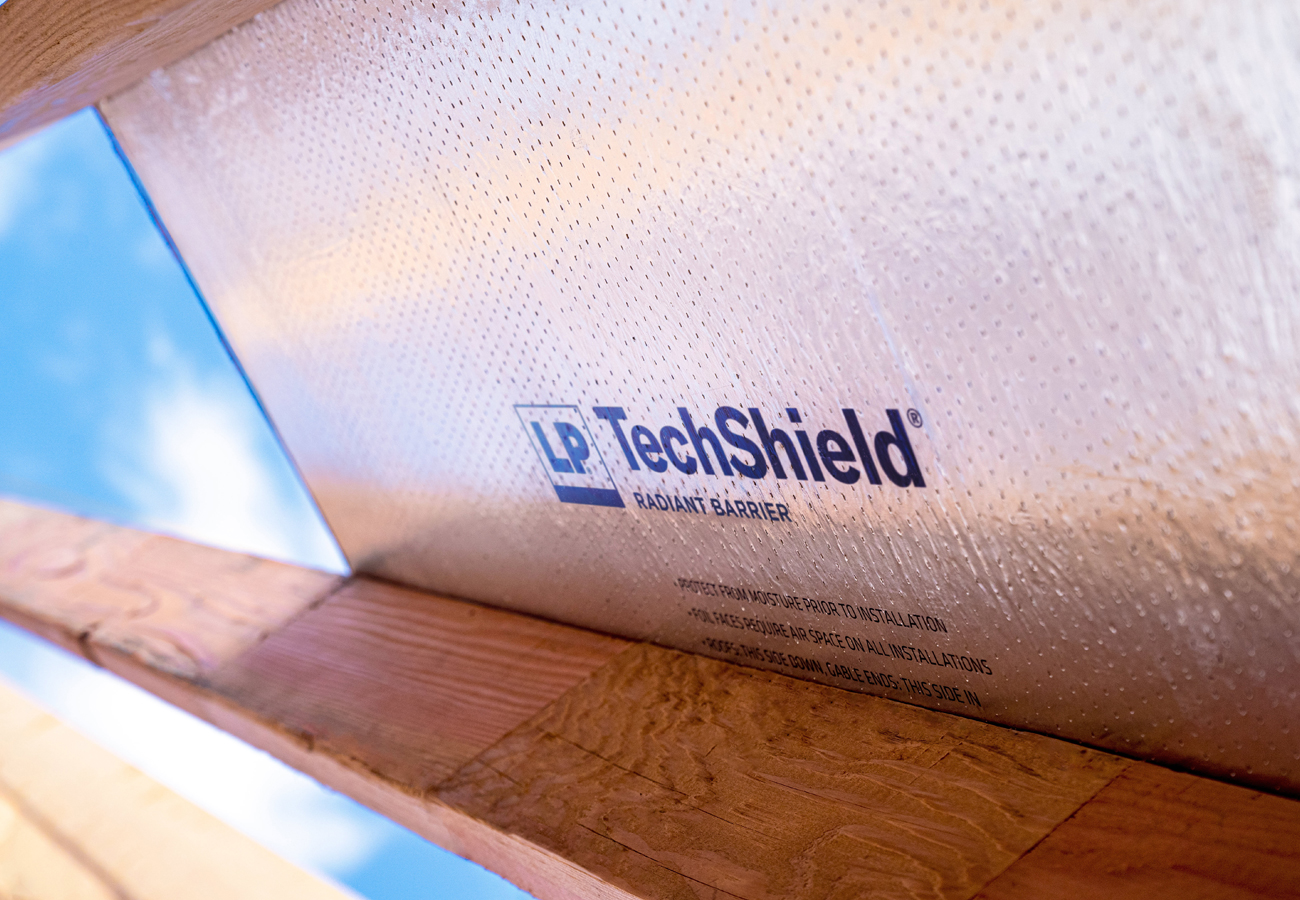Business Advice4 min
How to Install Radiant Barriers Under Shingles
Believe it or not, that's not such an unusual question. A lot of builders aren't sure about how to install a radiant barrier or-for that matter-how a radiant barrier works.
Although radiant barriers have been around for a couple of decades now, some builders have yet to discover the remarkable advantages that they offer.
So let's look into radiant barriers, how they work, what they do, and how to install them.
What is a radiant barrier?
A radiant barrier is a building material that reflects thermal radiation from the sun and reduces heat transfer into the attic and therefore into the house. Radiant barriers reflect thermal radiation thanks to a low emittance surface, typically a thin, mirror-like layer of aluminum foil on one side.
As the original and #1 brand of radiant barrier sheathing, LP® TechShield® panels have been installed in more than two million homes. It's the perfect example of a high performance radiant barrier.
With a thin, durable layer of aluminum pre-laminated to an OSB panel, LP TechShield sheathing blocks up to 97 % of radiant heat transfer through roof sheathing, which can lower attic temperatures by up to 30° F.
Keeping a home's attic cooler with a radiant barrier keeps the home itself cooler—and that can translate to lower energy bills.
Can you install radiant barriers under shingles?
The simple answer is yes. Radiant barrier sheathing is installed exactly like conventional roof sheathing, requiring no additional labor or installation time.
The beauty of radiant barrier roof sheathing is that you can install the underlayment and shingles right over it, just like you would for typical roof sheathing. That's because a radiant barrier is basically roof sheathing with an energy-efficiency secret.
The secret? The ability to work efficiently and effectively to reduce attic heat and reduce energy costs in the homes you build.
Still skeptical? Find out if radiant barriers really work.
What about moisture buildup?
Unwanted moisture is every builder's worst nightmare. Fortunately, this is where LP TechShield Radiant Barrier beats its competitors.
That's because LP TechShield sheathing features VaporVents™ technology that prevents moisture buildup during and after construction. A post-lamination foil incising process allows LP TechShield panels to dry more quickly than other radiant barrier panels when moisture occurs during construction. It also allows for continued moisture evaporation after installation.
No other brand of radiant barrier sheathing offers this very unique and very valuable technology feature.

How to install radiant barrier sheathing
A radiant barrier—like LP TechShield Radiant Barrier—is installed just like regular roof sheathing, so there are no additional labor costs.
Installation is simple. (Check out this brief installation video.)
The single most important thing to remember is this: the foil or radiant barrier side of the sheathing should always be placed down against the roof supports, not up. The foil side will be visible when you're inside the attic looking up at the underside of the roof.
A few other installation tips to remember:
Install with the long dimension or strength axis of the panel across supports and with the panel continuous over two or more spans.
Provide 1/8˝ minimum space at panel ends and edges. Use a spacer tool (like a 10d box nail) to assure accurate and consistent spacing.
Panel end-joints shall occur over framing. Stagger end joints in each succeeding row.
Provide additional panel stiffness by installing panel edge clips midspan on all unsupported edges.
What's the #1 radiant barrier?
If you're considering a radiant barrier, go with the best.
LP TechShield Radiant Barrier is America's original and #1 brand of radiant barrier sheathing. You can't go wrong with it.
There's one more reason to trust the homes you build to this proven performer. It's backed by a 20-Year Transferable Limited Warranty. So you and your homeowners get two decades of peace-of-mind protection.
Learn more about talking to homeowners about radiant barriers.
Continue Reading
Resiliency Solutions
5 minIntroducing LP® SmartSide® ExpertFinish® Naturals Collection™: Nature-Inspired Beauty Meets Engineered Performance
We're excited to introduce the LP® SmartSide® ExpertFinish® Naturals Collection™, a bold new addition to our trusted line of engineered wood siding and trim that delivers the warmth and beauty of nature with the advanced protection and performance builders and homeowners expect.
Labor Solutions
5 minChoosing the Right LP® Structural Solutions Product for Your Build
When it comes to building strong, reliable, and high-performing structures, the materials you choose matter. At LP Building Solutions, we understand that every project, whether it's a single-family home or a multifamily development, requires structural components that meet your needs for strength, durability, and efficiency.
Sustainability Solutions
5 minBuilding a More Sustainable Future with LP Building Solutions
In today's world, sustainability is no longer just a buzzword, it's a blueprint for responsible living and smarter building. As the construction industry seeks ways to reduce its environmental footprint, LP Building Solutions is focused on providing innovative building materials for eco-conscious builders to help reshape what it means to build sustainably
News & Stories3 min
History of Partnership with Gary Sinise Foundation
The LP Foundation is a proud partner of the Gary Sinise Foundation, which supports wounded veterans in several ways. You can learn more about the LP Foundation here.